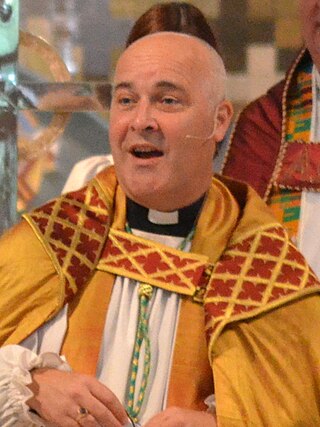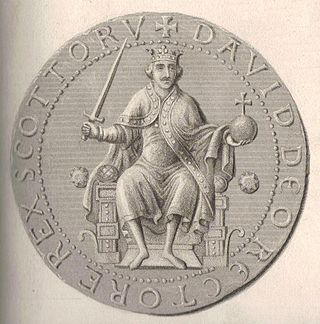Related Research Articles

Pope Honorius II, born Lamberto Scannabecchi, was head of the Catholic Church and ruler of the Papal States from 21 December 1124 to his death in 1130.
William de Corbeil or William of Corbeil was a medieval Archbishop of Canterbury. Very little is known of William's early life or his family, except that he was born at Corbeil, south of Paris, and that he had two brothers. Educated as a theologian, he taught briefly before serving the bishops of Durham and London as a clerk and subsequently becoming an Augustinian canon. William was elected to the See of Canterbury as a compromise candidate in 1123, the first canon to become an English archbishop. He succeeded Ralph d'Escures who had employed him as a chaplain.
Ralph d'Escures was a medieval abbot of Séez, bishop of Rochester, and then archbishop of Canterbury. He studied at the school at the Abbey of Bec. In 1079 he entered the abbey of St Martin at Séez and became abbot there in 1091. He was a friend of both Archbishop Anselm of Canterbury and Bishop Gundulf of Rochester, whose see, or bishopric, he took over on Gundulf's death.
Thurstan or Turstin of Bayeux was a medieval Archbishop of York, the son of a priest. He served kings William II and Henry I of England before his election to the see of York in 1114. Once elected, his consecration was delayed for five years while he fought attempts by the Archbishop of Canterbury to assert primacy over York. Eventually, he was consecrated by the pope instead and allowed to return to England. While archbishop, he secured two new suffragan bishops for his province. When Henry I died, Thurstan supported Henry's nephew Stephen of Blois as king. Thurstan also defended the northern part of England from invasion by the Scots, taking a leading part in organising the English forces at the Battle of the Standard (1138). Shortly before his death, Thurstan resigned from his see and took the habit of a Cluniac monk.
Wimund was a bishop who became a seafaring warlord adventurer in the years after 1147. His story is passed down to us by 12th-century English historian William of Newburgh in his Historia rerum anglicarum, Book I, Chapter 24 entitled "Of bishop Wimund, his life unbecoming a bishop, and how he was deprived of his sight".

The Tironensian Order or the Order of Tiron was a medieval monastic order named after the location of the mother abbey in the woods of Thiron-Gardais in Perche, some 35 miles west of Chartres in France). They were popularly called "Grey Monks" because of their grey robes, which their spiritual cousins, the monks of Savigny, also wore.

The Archdiocese of Glasgow was one of the thirteen dioceses of the Scottish church. It was the second largest diocese in the Kingdom of Scotland, including Clydesdale, Teviotdale, parts of Tweeddale, Liddesdale, Annandale, Nithsdale, Cunninghame, Kyle, and Strathgryfe, as well as Lennox, Carrick and the part of Galloway known as Desnes.

Andrew Forman was a Scottish diplomat and prelate who became Bishop of Moray in 1501, Archbishop of Bourges in France, in 1513, Archbishop of St Andrews in 1514 as well as being Commendator of several monasteries.

Dundrennan Abbey, in Dundrennan, Scotland, near to Kirkcudbright, was a Cistercian monastery in the Romanesque architectural style, established in 1142 by Fergus of Galloway, King David I of Scotland (1124–53), and monks from Rievaulx Abbey. Though extensively ruined, Dundrennan is noted for the purity and restraint of its architecture, reflecting the austere Cistercian ideal. It is also built from very hard-weathering grey sandstone, so the original architectural forms and mouldings are well preserved.
GilleAldan, of Whithorn, was a native Galwegian who was the first Bishop of the resurrected Bishopric of Whithorn or Galloway. He was the first to be consecrated by the Archbishop of York, who at that time was Thurstan. The re-creation of the Bishopric suited both the ruler of Galloway, Fergus, and the Archbishop, who had few suffragans and needed more in order to maintain his independence from Canterbury.
Christianity in medieval Scotland includes all aspects of Christianity in the modern borders of Scotland in the Middle Ages. Christianity was probably introduced to what is now Lowland Scotland by Roman soldiers stationed in the north of the province of Britannia. After the collapse of Roman authority in the fifth century, Christianity is presumed to have survived among the British enclaves in the south of what is now Scotland, but retreated as the pagan Anglo-Saxons advanced. Scotland was largely converted by Irish missions associated with figures such as St Columba, from the fifth to the seventh centuries. These missions founded monastic institutions and collegiate churches that served large areas. Scholars have identified a distinctive form of Celtic Christianity, in which abbots were more significant than bishops, attitudes to clerical celibacy were more relaxed and there were significant differences in practice with Roman Christianity, particularly the form of tonsure and the method of calculating Easter, although most of these issues had been resolved by the mid-seventh century. After the reconversion of Scandinavian Scotland in the tenth century, Christianity under papal authority was the dominant religion of the kingdom.
Robert of Scone was a 12th-century bishop of Cell Rígmonaid. Robert's exact origins are unclear. He was an Augustinian canon at the Priory of St. Oswalds, at Nostell. His French name indicates a Norman rather than an Anglo-Saxon origin, but as he was likely born in the later 11th century, this may be due merely to the acculturation of his parents.

The archbishop of York is a senior bishop in the Church of England, second only to the archbishop of Canterbury. The archbishop is the diocesan bishop of the Diocese of York and the metropolitan bishop of the province of York, which covers the northern regions of England as well as the Isle of Man.
The Abbot of Kelso was the head of the Tironensian monastic community at Kelso Abbey in the Scottish Borders. The Abbey was originally founded at Selkirk in 1113 by David, Prince of the Cumbrians, and thus the first three Abbots were Abbots of Selkirk. The community was moved to Kelso by David and John, Bishop of Glasgow in 1127. The abbot was the first in Scotland to be granted the mitre in 1165. In the 16th century the monastery increasingly came under secular control, and finally in 1607 it was granted as a secular lordship (Holydean) to its last commendator, Robert Ker of Cesford, later Earl of Roxburghe. The following is a list of abbots and commendators:
Herbert of Selkirk was a 12th-century Tironensian monk, who rose to become 3rd Abbot of Selkirk-Kelso and bishop of Glasgow. While abbot of Selkirk, King David I of Scotland moved Selkirk Abbey to nearby Kelso. He was elected to the see of Glasgow soon after the death of his Bishop John, and consecrated by Pope Eugenius III at Auxerre on St Bartholomew's Day, 24 August 1147. He died in 1164.
Walter Capellanus was an important cleric and politician in the Kingdom of Scotland during the reigns of kings William the Lion and Alexander II.

The Davidian Revolution is a name given by many scholars to the changes which took place in the Kingdom of Scotland during the reign of David I (1124–1153). These included his foundation of burghs, implementation of the ideals of Gregorian Reform, foundation of monasteries, Normanisation of the Scottish government, and the introduction of feudalism through immigrant Norman and Anglo-Norman knights.

Historical treatment of David I and the Scottish church usually emphasises King David I of Scotland's pioneering role as the instrument of diocesan reorganisation and Norman penetration, beginning with the bishopric of Glasgow while David was Prince of the Cumbrians, and continuing further north after David acceded to the throne of Scotland. As well as this and his monastic patronage, focus too is usually given to his role as the defender of the Scottish church's independence from claims of overlordship by the Archbishop of York and the Archbishop of Canterbury.
Robert Lauder was a Scottish prelate and Nuncio of the 15th century. The Lauder family produced a large number of senior churchman in this period, and alongside Robert can be named William Lauder, Bishop of Glasgow, Alexander Lauder and Thomas Lauder, both Bishop of Dunkeld, and George Lauder, Bishop of Argyll.

Cum universi is a papal bull written by Pope Celestine III, issued on 13 March 1192. The bull ended the claim of the Archbishop of York to metropolitan jurisdiction in Scotland and established an independent national church, albeit one with no figurehead.
References
- Anderson, Alan O., ed. (1908), Scottish Annals from English Chroniclers A.D. 500 to 1286, London: David Nutt, p. 159
- Duncan, A.A.M., Scotland: The Making of the Kingdom, (Edinburgh, 1975)
- Oram, Richard, David: The King Who Made Scotland, (Gloucestershire, 2004)